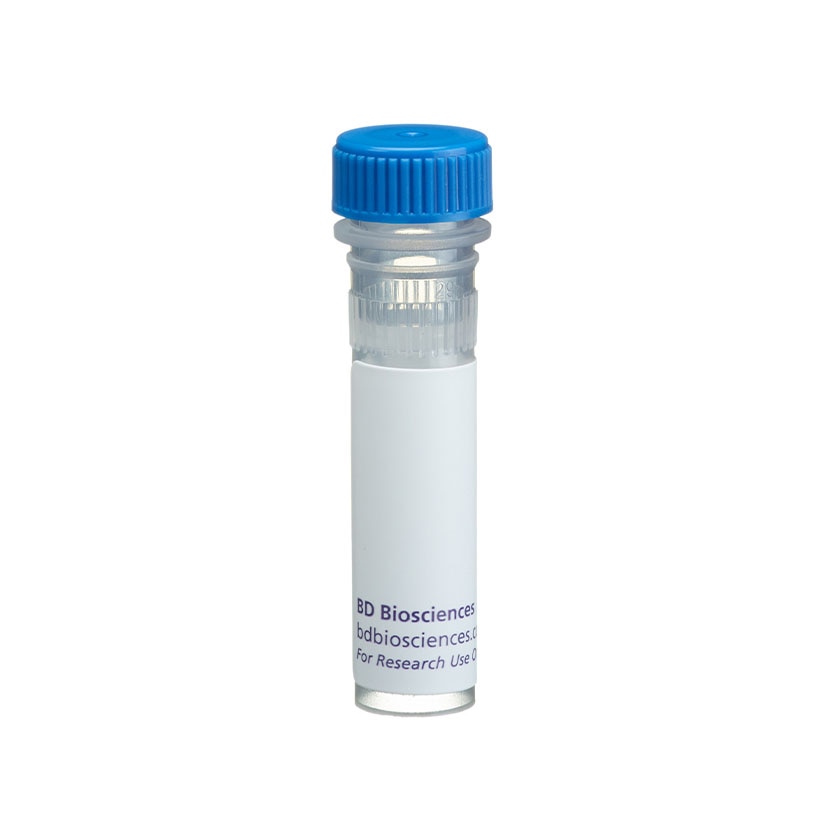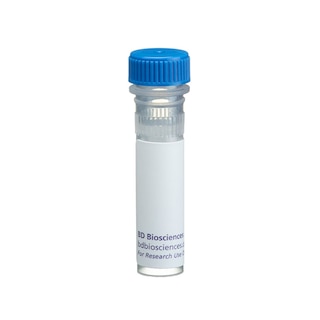-
Reagents
- Flow Cytometry Reagents
-
Western Blotting and Molecular Reagents
- Immunoassay Reagents
-
Single-Cell Multiomics Reagents
- BD® OMICS-Guard Sample Preservation Buffer
- BD® AbSeq Assay
- BD® Single-Cell Multiplexing Kit
- BD Rhapsody™ ATAC-Seq Assays
- BD Rhapsody™ Whole Transcriptome Analysis (WTA) Amplification Kit
- BD Rhapsody™ TCR/BCR Next Multiomic Assays
- BD Rhapsody™ Targeted mRNA Kits
- BD Rhapsody™ Accessory Kits
- BD® OMICS-One Protein Panels
- BD OMICS-One™ WTA Next Assay
-
Functional Assays
-
Microscopy and Imaging Reagents
-
Cell Preparation and Separation Reagents
Old Browser
This page has been recently translated and is available in French now.
Looks like you're visiting us from {countryName}.
Would you like to stay on the current location site or be switched to your location?
BD Pharmingen™ Purified Mouse Anti-Rat mGluR1α
Clone G209-2048 (RUO)

Immunohistochemical staining of mGluR1α on rat brain sections. Formalin fixed paraffin embedded rat brain sections were stained with either Purified Mouse IgG1, κ Isotype Control (Cat. No. 550878; Left Panel) or Purified Mouse anti-Rat mGluR1α (Cat. No 556389; Right Panel). Pretreatment is not needed. Original magnification is 20X. Antibodies were used at 0.5 - 2.0 µg/mL. Development was assisted with the Anti-Mouse Ig HRP Detection Kit (Cat. No. 551011).

Western blot analysis of mGluR1α expression on rat cerebellum and mouse brain. Rat cerebellum (left panel) and mouse brain (right panel) lysates were stained with Purified Mouse Anti-Rat mGluR1α at 0.125 (lanes 1) and 0.0625 (lanes 2) ug/ml for 2 hours at room temperature. Secondary staining was carried out with HRP Goat Anti-Mouse Ig (Cat. No. 556389) for 1 hour at room temperature, with an exposure time of 1 second. mGluR1α is identified as a 133 kDa band.




Immunohistochemical staining of mGluR1α on rat brain sections. Formalin fixed paraffin embedded rat brain sections were stained with either Purified Mouse IgG1, κ Isotype Control (Cat. No. 550878; Left Panel) or Purified Mouse anti-Rat mGluR1α (Cat. No 556389; Right Panel). Pretreatment is not needed. Original magnification is 20X. Antibodies were used at 0.5 - 2.0 µg/mL. Development was assisted with the Anti-Mouse Ig HRP Detection Kit (Cat. No. 551011).
Western blot analysis of mGluR1α expression on rat cerebellum and mouse brain. Rat cerebellum (left panel) and mouse brain (right panel) lysates were stained with Purified Mouse Anti-Rat mGluR1α at 0.125 (lanes 1) and 0.0625 (lanes 2) ug/ml for 2 hours at room temperature. Secondary staining was carried out with HRP Goat Anti-Mouse Ig (Cat. No. 556389) for 1 hour at room temperature, with an exposure time of 1 second. mGluR1α is identified as a 133 kDa band.


Immunohistochemical staining of mGluR1α on rat brain sections. Formalin fixed paraffin embedded rat brain sections were stained with either Purified Mouse IgG1, κ Isotype Control (Cat. No. 550878; Left Panel) or Purified Mouse anti-Rat mGluR1α (Cat. No 556389; Right Panel). Pretreatment is not needed. Original magnification is 20X. Antibodies were used at 0.5 - 2.0 µg/mL. Development was assisted with the Anti-Mouse Ig HRP Detection Kit (Cat. No. 551011).

Western blot analysis of mGluR1α expression on rat cerebellum and mouse brain. Rat cerebellum (left panel) and mouse brain (right panel) lysates were stained with Purified Mouse Anti-Rat mGluR1α at 0.125 (lanes 1) and 0.0625 (lanes 2) ug/ml for 2 hours at room temperature. Secondary staining was carried out with HRP Goat Anti-Mouse Ig (Cat. No. 556389) for 1 hour at room temperature, with an exposure time of 1 second. mGluR1α is identified as a 133 kDa band.





Regulatory Status Legend
Any use of products other than the permitted use without the express written authorization of Becton, Dickinson and Company is strictly prohibited.
Preparation And Storage
Product Notices
- Since applications vary, each investigator should titrate the reagent to obtain optimal results.
- Caution: Sodium azide yields highly toxic hydrazoic acid under acidic conditions. Dilute azide compounds in running water before discarding to avoid accumulation of potentially explosive deposits in plumbing.
- Sodium azide is a reversible inhibitor of oxidative metabolism; therefore, antibody preparations containing this preservative agent must not be used in cell cultures nor injected into animals. Sodium azide may be removed by washing stained cells or plate-bound antibody or dialyzing soluble antibody in sodium azide-free buffer. Since endotoxin may also affect the results of functional studies, we recommend the NA/LE (No Azide/Low Endotoxin) antibody format, if available, for in vitro and in vivo use.
- Please refer to http://regdocs.bd.com to access safety data sheets (SDS).
- Species cross-reactivity detected in product development may not have been confirmed on every format and/or application.
- Please refer to www.bdbiosciences.com/us/s/resources for technical protocols.
Companion Products



Glutamate is a major excitatory neurotransmitter in mammalian brain. Glutamatergic neurotransmission is mediated by a family of glutamate receptors that can be grouped into two classes, ionotropic (GluR) and metabotropic (mGluR) receptors. The metabotropic glutamate receptors consist of at least seven subtypes that can be divided into three groups on the basis of their sequence similarities, intracellular second messengers and agonist selectivities. These groups are: 1) mGluR1 and mGluR5; 2) mGluR2 and mGluR3; and 3) mGluR4, mGluR6 and mGluR7. mGluR1 and mGluR5 are coupled to the inositol phosphate/Ca[2+] signal transduction pathway, whereas the other five receptors are linked to the inhibition of the cAMP cascade. mRNA analysis shows that the seven receptors have different expression patterns in the central nervous system. For example, the highest level of mGluR1 mRNA expression is found in the cerebellar Purkinje cells. mGluR7 mRNA is moderately expressed in these cells, whereas the mRNA of the other five mGluRs is barely detectable. Three splice variants have been described for mGluR1: mGluR1α (145 kDa), mGluR1β (97 kDa), and mGluR1c (97 kDa).
Clone G209-2048 recognizes rat mGluR1α. It does not cross-react with the other splice mGluR1 variants, mGluR1β, and mGluR1c. Additionally, G209-2048 does not cross-react with mGluR5, the most closely related mGluR family member. A full length recombinant rat mGluR1 fusion protein was used as immunogen.
Development References (3)
-
Masu M, Tanabe Y, Tsuchida K, Shigemoto R, Nakanishi S. Sequence and expression of a metabotropic glutamate receptor. Nature. 1991; 349(6312):760-765. (Biology). View Reference
-
Shigemoto R, Abe T, Nomura S, Nakanishi S, Hirano T. Antibodies inactivating mGluR1 metabotropic glutamate receptor block long-term depression in cultured Purkinje cells. Neuron. 1994; 12(6):1245-1255. (Biology). View Reference
-
Shigemoto R, Nakanishi S, Mizuno N. Distribution of the mRNA for a metabotropic glutamate receptor (mGluR1) in the central nervous system: an in situ hybridization study in adult and developing rat. J Comp Neurol. 1992; 322(1):121-135. (Biology). View Reference
Please refer to Support Documents for Quality Certificates
Global - Refer to manufacturer's instructions for use and related User Manuals and Technical data sheets before using this products as described
Comparisons, where applicable, are made against older BD Technology, manual methods or are general performance claims. Comparisons are not made against non-BD technologies, unless otherwise noted.
For Research Use Only. Not for use in diagnostic or therapeutic procedures.